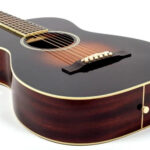The Fender VI, often referred to as the Bass VI, stands as a unique instrument in the guitar and bass world. Recently revitalized by Fender and Squier, this six-string bass guitar, in both its modern and classic forms, continues to intrigue musicians. Originally introduced from 1961 to 1975 and reintroduced later, the Bass VI is definitively designed and marketed as a bass guitar, not to be confused with a baritone guitar.
But what truly sets the Bass VI apart from a baritone guitar? Beyond mere semantics, understanding the distinct characteristics of each instrument is crucial for players seeking specific sonic territories.
Baritone guitars are fundamentally guitars, built with guitar construction principles in mind. They are strung with guitar strings and typically feature a scale length around 27 inches. This scale length bridges the gap between standard guitars (approximately 25 inches) and bass guitars (typically 34 inches, with short-scale models around 30 inches and medium-scale around 32 inches). Baritone guitars rarely employ standard EADGBE tuning; instead, they are commonly tuned a fourth lower (BEADF#B), where the fifth string E aligns with the low E string of a standard guitar. Alternative tunings for baritone guitars include a fifth lower (ADGCEA) or even a major third lower (CFBbEbGC) than standard guitar tuning, offering a range of lower registers for guitarists.
Image alt text: Squier Vintage Modified Bass VI in Black, showcasing its six-string configuration and classic body shape.
In contrast, the current Fender and Squier Bass VI models, much like the original Fender Bass VI, are classified as bass guitars. They utilize bass guitar strings, albeit a specialized set tailored for the instrument. Featuring a 30-inch scale length, similar to many short-scale basses, they are tuned to standard EADGBE tuning, but an octave lower than a standard guitar. This lower octave tuning is a key factor distinguishing the Bass VI and defining its sonic role.
While alternate tunings can be applied to a Bass VI, this does not transform it into a baritone guitar. It simply becomes a Bass VI with a different tuning setup. Conversely, attempting to use bass strings on a baritone guitar would be impractical. Bass strings would likely be too loose and floppy on a shorter 27-inch scale instrument, rendering them unusable, and the tuners on a baritone guitar are typically not designed to accommodate the thicker gauge of bass guitar strings.
Therefore, the distinction is not merely semantic. As Fender has consistently positioned and characterized the Bass VI, “six-string bass guitar” and “baritone guitar” are not interchangeable terms. Despite seemingly subtle differences, they represent two distinct instrument categories, each with its own purpose and playing style.
Historically, when Fender has introduced true baritone electric guitars, they have been explicitly labeled as such. Examples include the Sub-Sonic Baritone Stratocaster (2000-2002), the Jaguar Baritone Special HH (2005-2010), and the Blacktop Telecaster Baritone (2012-present). All these baritone models share a common 27-inch scale length, further emphasizing the scale length difference as a defining characteristic.
To reiterate, both vintage and contemporary Bass VI models are considered and have always been marketed by Fender as bass guitars. This consistent categorization reinforces the Bass VI’s identity within the bass family.
Image alt text: Close-up of a Fender VI headstock, highlighting the “Fender VI” logo and tuning pegs designed for bass strings.
Interestingly, the modern Bass VI reissues do not bear the “Bass VI” designation on the headstock. Instead, they are labeled “Fender VI” and “Squier VI,” respectively. This aligns with the original instrument’s branding, which featured “Fender VI” on the headstock, even though Fender’s 1961 catalog initially described it as a “New Fender bass guitar,” and subsequently as the “Bass VI guitar” and “Bass VI” in later catalogs throughout the 1960s and 1970s. This branding evolution reflects the instrument’s unique position and evolving perception.
Interested in expanding your guitar knowledge? Explore informative videos offered by Fender Play. And if you’re new to Fender Play, you can begin with a free trial.

